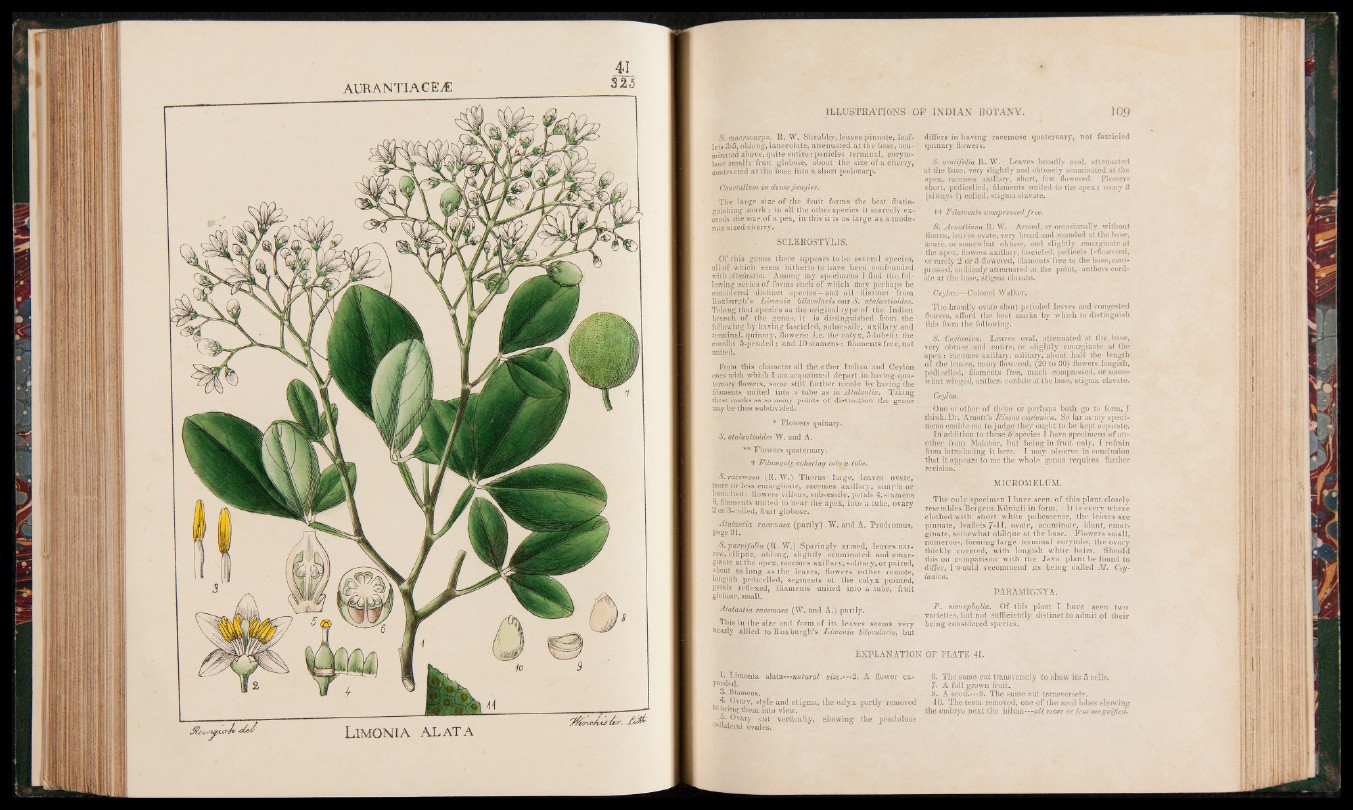
AURANTIACEÆ
4L 32,5
Limoni a al a t a
ILLUSTRATIONS O P INDIAN BOTANY. 109
S. macrocurpa. R. W. Shrubby, leaves pinnate, leaflets
3-5, oblong, lanceolate, attenuated at the base, acuminated
above, quite entire: panicles terminal, corymbose
small : fruit globose, about the size of a cherry,
contracted at the base into a short podocarp.
Courtallum in dense jungles.
The large size of the fruit forms the best distinguishing
mark: in all the other species it scarcely exceeds
the size of a pea, in this it is as large as a moderate
sized cherry.
SCLEROSTYLIS.
Of this genus there appears to be several species,
all of which seem hitherto to have been confounded
with Atalantiw. Among my specimens I find the. following
series of forms each of which may perhaps be
considered distinct species—and all distinct from
Roxburgh’s Limonia bilocularis our S. atalantioides.
Taking that species as the original type of the Indian
branch of the genus, it is distinguished from the
following by having fascicled-, subsessile, axillary and
terminal, quinary, flowers: i.e. the calyx, 5-lobed: the
corolla 5-petaled : and 1 0 stamens: filaments free,not
united.
From this character all the other Indian and Ceylon
ones with which I am acquainted depart in having-quaternary
flowers, some still further recede by having the
filaments united into a tube as in Atalantia. Talcing
these marks as so many points of distinction the genus
may be thus subdivided.
* Flowers quinary.
. S. atalantioides W. and A.
** Flowers quaternary,
f Filameutfi cohering into a tube.
S. racemosa (R. W.) Thorns large, leaves ovate,
more or less e margin ate, racemes -axillary, simple or
branched : flowers villous, subsessile, petals 4, stamens
8, filaments united to near the apex, into a tube, ovary
2 or 3-celied, fruit globose.
Atalantia racemosa (partly)page 91. W. and A. Prodromus,
o . parvifolia (R. W.) Sparingly armed, leaves narrow,
elliptic, oblong, slightly acuminated and emar-
ginate at the apex, racemes axillary, solitary,.or paired,
about as long as the leaves, flowers rather remote,
longish pedicelled, segments of the calyx pointfed,
petals reflexed, filaments united into a tube, fruit
globose, small.
Atalantia racemosa (W. and A.) partly.
This in the size and form of its leaves seems very'
nearly allied to Roxburgh’s Limonia bilocularis, but
EXPLANATION
L Limonia alata—natural size.— 2. A flower expanded.
3. Stamens.
4. Ovary, style and stigma, the calyx partly removed
to bring them into view.
.5. Ovary cut vertically, showing the pendulous
collateral ovules.
differs in having racemose quaternary, not fascicled
quinary flowers.
5. ovalifolia R. W. Leaves broadly oval, attenuated
at the base, very slightly and obtusely acuminated at the
apex, racemes axillary, short, few flowered. Flowers
short, pedicelled, filaments united to the apex; ovary 3
(always ?)' celled, stigma clavate.
t f Filaments compressed fr e e .
6. Arnottiana Ji. W. Armed, or occasionally without
thorns, leaves ovate, very broad and rounded at the base,
acute, or somewhat obtuse, and slightly emarginate at
the apex, flowers axillary, fascicled, pedicels 1-flowered,
or rarely 2 or 3 flowered, filaments free to the base, compressed,
suddenly attenuated at the point, anthers cordate
at the base, stigma clavate.
Ceylon.—Colonel Walker.
The broadly ovate short petioled leaves and congested
flowers, afford the best marks by which to distinguish
this from the following.
S. Ceylanica. Leaves oval, attenuated at the base,
very obtuse and entire, or slightly emarginate at the
apex: racemes axillary, solitary, about half the length
of the leaves, many flowered, (20 to 30) flowers longish,
pedicelled, filaments free, much compressed, or somewhat
winged, anthers cordate at the base, stigma clavate.
Ceylon.
One or other of these or perhaps both go to form, I
think, Dr. Arnott’s Rissoa ceylanica. So far as my specimens
enable me to judge they ought to be kept separate.
In addition to these \5 ‘species I have specimens of another.
from Malabar, but being in fruit only, I refrain
from introducing it here. I may observe in conclusion
that it appears to me the whole genus requires further
revision.
MICROMELUM.
The only specimen I have seen of this plant closely
resembles Bergera Konigii in form. It is every where
clothed with short white pubescence, the leaves are
pinnate, leaflets 7-11, ovate, acuminate, blunt, emarginate,
somewhat oblique at the base. Flowers small,
numerous, forming large terminal corymbs, the ovary
thickly covered, with longish white hairs. Should
this on comparison with the Java plant be found to
differ, I would recommend its being called M. Ceylanica.
PARAMIGNYA.
P . monophylla. Of this plant I have seen two
varieties, but not sufficiently distinct to admit of their
being considered species.
OF PLATE 41.
6. The same cut transversely to show its 5 cells.
7- A full grown fruit.
8. A seed.—9. The same cut transversely.
10. The testa removed, one of the seed lobes showing
the embryo next the hilum---«^ more or less magnified.